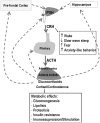REM Sleep Rebound as an Adaptive Response to Stressful Situations
- PMID: 22485105
- PMCID: PMC3317042
- DOI: 10.3389/fneur.2012.00041
REM Sleep Rebound as an Adaptive Response to Stressful Situations
Abstract
Stress and sleep are related to each other in a bidirectional way. If on one hand poor or inadequate sleep exacerbates emotional, behavioral, and stress-related responses, on the other hand acute stress induces sleep rebound, most likely as a way to cope with the adverse stimuli. Chronic, as opposed to acute, stress impairs sleep and has been claimed to be one of the triggering factors of emotional-related sleep disorders, such as insomnia, depressive- and anxiety-disorders. These outcomes are dependent on individual psychobiological characteristics, conferring even more complexity to the stress-sleep relationship. Its neurobiology has only recently begun to be explored, through animal models, which are also valuable for the development of potential therapeutic agents and preventive actions. This review seeks to present data on the effects of stress on sleep and the different approaches used to study this relationship as well as possible neurobiological underpinnings and mechanisms involved. The results of numerous studies in humans and animals indicate that increased sleep, especially the rapid eye movement phase, following a stressful situation is an important adaptive behavior for recovery. However, this endogenous advantage appears to be impaired in human beings and rodent strains that exhibit high levels of anxiety and anxiety-like behavior.
Keywords: HPA axis; REM sleep; animal models; anxiety-related behavior; prolactin; sleep; stress.
Figures




Similar articles
-
Repeated exposure to conditioned fear stress increases anxiety and delays sleep recovery following exposure to an acute traumatic stressor.Front Psychiatry. 2014 Oct 20;5:146. doi: 10.3389/fpsyt.2014.00146. eCollection 2014. Front Psychiatry. 2014. PMID: 25368585 Free PMC article.
-
Emotion, emotion regulation and sleep: An intimate relationship.AIMS Neurosci. 2017 Dec 1;5(1):1-17. doi: 10.3934/Neuroscience.2018.1.1. eCollection 2018. AIMS Neurosci. 2017. PMID: 32341948 Free PMC article. Review.
-
Brain prolactin is involved in stress-induced REM sleep rebound.Horm Behav. 2017 Mar;89:38-47. doi: 10.1016/j.yhbeh.2016.12.004. Epub 2016 Dec 23. Horm Behav. 2017. PMID: 28017595
-
Main neuroendocrine features and therapy in primary sleep troubles.Rev Med Chir Soc Med Nat Iasi. 2012 Jul-Sep;116(3):862-6. Rev Med Chir Soc Med Nat Iasi. 2012. PMID: 23272543
-
The organization of the stress system and its dysregulation in depressive illness.Mol Psychiatry. 2015 Feb;20(1):32-47. doi: 10.1038/mp.2014.163. Epub 2014 Dec 9. Mol Psychiatry. 2015. PMID: 25486982 Review.
Cited by
-
Balancing brain metabolic states during sickness and recovery sleep.Eur J Neurosci. 2024 Dec;60(11):6605-6616. doi: 10.1111/ejn.16588. Epub 2024 Nov 14. Eur J Neurosci. 2024. PMID: 39542871 Free PMC article.
-
Increased Serum Prolactin and Excessive Daytime Sleepiness: An Attempt of Proof-of-Concept Study.Brain Sci. 2021 Nov 28;11(12):1574. doi: 10.3390/brainsci11121574. Brain Sci. 2021. PMID: 34942875 Free PMC article.
-
New hypothesis and treatment targets of depression: an integrated view of key findings.Neurosci Bull. 2015 Feb;31(1):61-74. doi: 10.1007/s12264-014-1486-4. Epub 2015 Jan 9. Neurosci Bull. 2015. PMID: 25575479 Free PMC article. Review.
-
Sleep Disturbances and Depression Are Co-morbid Conditions: Insights From Animal Models, Especially Non-human Primate Model.Front Psychiatry. 2022 Jan 25;12:827541. doi: 10.3389/fpsyt.2021.827541. eCollection 2021. Front Psychiatry. 2022. PMID: 35145441 Free PMC article. Review.
-
Pivotal mental states.J Psychopharmacol. 2021 Apr;35(4):319-352. doi: 10.1177/0269881120959637. Epub 2020 Nov 11. J Psychopharmacol. 2021. PMID: 33174492 Free PMC article. Review.
References
-
- Agid O., Shapira B., Zislin J., Ritsner M., Hanin B., Murad H., Troudart T., Bloch M., Heresco-Levy U., Lerer B. (1999). Environment and vulnerability to major psychiatric illness: a case control study of early parental loss in major depression, bipolar disorder and schizophrenia. Mol. Psychiatry 4, 163–17210.1038/sj.mp.4000473 - DOI - PubMed
-
- Balsa J. A., Sanchez-Franco F., Pazos F., Lara J. I., Lorenzo M. J., Maldonado G., Cacicedo L. (1998). Direct action of serotonin on prolactin, growth hormone, corticotropin and luteinizing hormone release in cocultures of anterior and posterior pituitary lobes: autocrine and/or paracrine action of vasoactive intestinal peptide. Neuroendocrinology 68, 326–33310.1159/000054381 - DOI - PubMed
-
- Barbosa Neto J. B., Tiba P. A., Faturi C. B., de Castro-Neto E. F., da Graca Naffah-Mazacoratti M., de Jesus Mari J., de Mello M. F., Suchecki D. (2012). Stress during development alters anxiety-like behavior and hippocampal neurotransmission in male and female rats. Neuropharmacology 62, 518–52610.1016/j.neuropharm.2011.09.011 - DOI - PubMed
LinkOut - more resources
Full Text Sources

